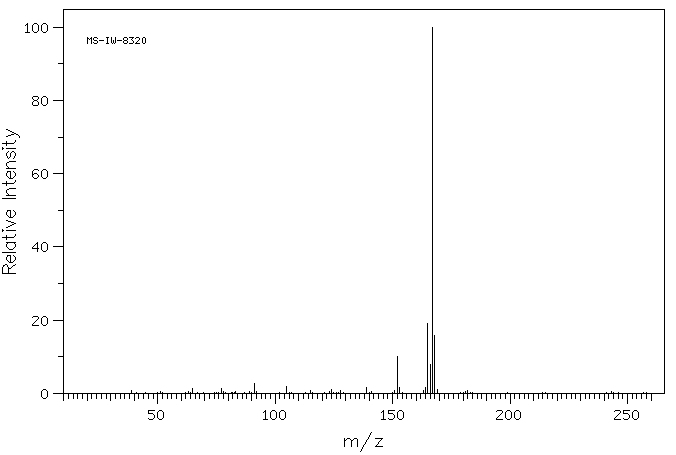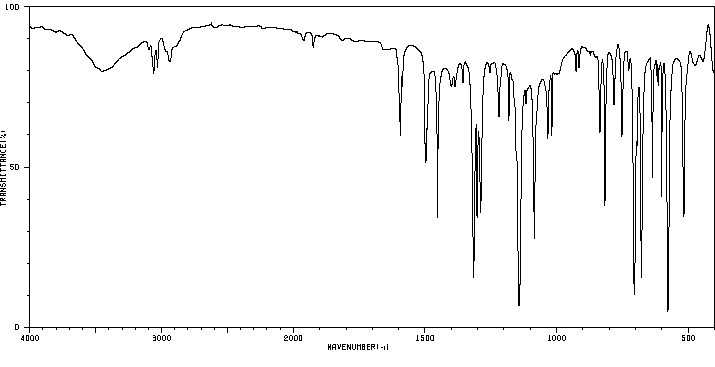(tosylmethylene)dibenzene | 5433-78-3
中文名称
——
中文别名
——
英文名称
(tosylmethylene)dibenzene
英文别名
Benzhydryl-p-tolyl-sulfon;Diphenylmethyl-p-tolyl-sulfon;Benzhydryl-p-toluolsulfon;diphenylmethyl p-tolyl sulfone;p-Tolylsulfon-diphenyl-methan;benzhydryl-p-tolyl sulfone;4-Diphenylmethylsulfon-toluol;4-Benzhydrylsulfon-toluol;1-Benzhydrylsulfonyl-4-methylbenzene
CAS
5433-78-3
化学式
C20H18O2S
mdl
——
分子量
322.428
InChiKey
ORXRCDKWDCEGFY-UHFFFAOYSA-N
BEILSTEIN
——
EINECS
——
-
物化性质
-
计算性质
-
ADMET
-
安全信息
-
SDS
-
制备方法与用途
-
上下游信息
-
文献信息
-
表征谱图
-
同类化合物
-
相关功能分类
-
相关结构分类
计算性质
-
辛醇/水分配系数(LogP):4.7
-
重原子数:23
-
可旋转键数:4
-
环数:3.0
-
sp3杂化的碳原子比例:0.1
-
拓扑面积:42.5
-
氢给体数:0
-
氢受体数:2
SDS
上下游信息
反应信息
-
作为反应物:描述:(tosylmethylene)dibenzene 在 三乙基硅烷 、 aluminum (III) chloride 作用下, 以 二氯甲烷 为溶剂, 反应 1.0h, 以88%的产率得到二苯基甲烷参考文献:名称:Palladium-catalyzed benzylic direct arylation of benzyl sulfones with aryl halides摘要:An effective palladium catalyst system for the direct arylation of benzyl sulfones with aryl halides has been developed. The catalytic reaction provides a facile route to diarylmethyl sulfones. The products can be transformed further via desulfonylative functionalization mediated by aluminum compounds. (C) 2009 Elsevier Ltd. All rights reserved.DOI:10.1016/j.tet.2009.01.030
-
作为产物:描述:对甲苯磺酰肼 在 dipotassium hydrogenphosphate 、 bis(η3-allyl-μ-chloropalladium(II)) 、 (4,4'-di-tert-butyl-2,2'-dipyridyl)-bis-(2-phenylpyridine(-1H))-iridium(III) hexafluorophosphate 、 potassium tert-butylate 、 三环己基膦 作用下, 以 甲醇 、 N,N-二甲基甲酰胺 、 甲苯 为溶剂, 反应 48.0h, 生成 (tosylmethylene)dibenzene参考文献:名称:Visible-Light-Catalyzed in Situ Denitrogenative Sulfonylation of Sulfonylhydrazones摘要:DOI:10.1021/acs.orglett.1c02369
文献信息
-
Nickel-Catalyzed Kumada Reaction of Tosylalkanes with Grignard Reagents to Produce Alkenes and Modified Arylketones作者:Ji-Cheng Wu、Lu-Bing Gong、Yuanzhi Xia、Ren-Jie Song、Ye-Xiang Xie、Jin-Heng LiDOI:10.1002/anie.201205969日期:2012.9.24Open a new door: The first example of alkene synthesis from alkyl electrophiles with Grignard reagents using the Kumada cross‐coupling reaction strategy is reported. This method opens a new door for the Kumada cross‐coupling reaction, allowing alkenes to be prepared from the reaction of tosylalkanes with Grignard reagents.
-
Copper-Catalyzed Nitrogen Loss of Sulfonylhydrazones: A Reductive Strategy for the Synthesis of Sulfones from Carbonyl Compounds作者:Xing-Wen Feng、Jian Wang、Ji Zhang、Jing Yang、Na Wang、Xiao-Qi YuDOI:10.1021/ol101955x日期:2010.10.1An efficient method for the synthesis of sulfones via nitrogen loss of sulfonyl hydrazones is described. The reaction was performed in the presence of simple copper salt and base by utilization of sulfonyl hydrazones, which were easily prepared from carbonyl compounds. A wide variety of aryl and alkyl sulfones were obtained in moderate to good yields.描述了一种通过磺酰基的氮损失合成砜的有效方法。该反应在简单的铜盐和碱的存在下通过利用磺酰基来进行,所述磺酰基易于从羰基化合物制备。以中等至良好的产率获得了各种各样的芳基和烷基砜。
-
Substrate- and temperature-controlled divergence in reactions of alcohols with TosMIC catalyzed by BF<sub>3</sub> · Et<sub>2</sub>O: Facile access to sulfinates and sulfones作者:Naresh Pogaku、Palakodety Radha Krishna、Y. Lakshmi PrapurnaDOI:10.1080/00397911.2017.1321128日期:2017.7.3ABSTRACT An efficient BF3 · Et2O-catalyzed divergent synthesis of sulfinate esters and sulfones through C–O and C–S bond formation has been achieved from alcohols and p-toluenesulfonylmethyl isocyanide (TosMIC). Various alcohols reacted smoothly with TosMIC under the present conditions at room temperature providing sulfinate esters exclusively. By tuning the reaction temperature, the alcohols that
-
Iron(III) Chloride‐Catalyzed Direct Sulfonylation of Alcohols with Sodium Arenesulfinates作者:M. Amarnath Reddy、P. Surendra Reddy、B. SreedharDOI:10.1002/adsc.200900905日期:2010.10.9A new protocol for the direct sulfonylation of benzylic, allylic and homoallylic alcohols with sodium arenesulfinates is described by using iron(III) chloride as a catalyst and chlorotrimethylsilane as an additive. This method requires no preactivation of alcohols. Surprisingly in the reaction with homoallyl alcohols nucleophilic addition of sulfinate anion, occurs at the terminal double bond instead
-
Balfe et al., Journal of the Chemical Society, 1942, p. 605,610作者:Balfe et al.DOI:——日期:——
表征谱图
-
氢谱1HNMR
-
质谱MS
-
碳谱13CNMR
-
红外IR
-
拉曼Raman
-
峰位数据
-
峰位匹配
-
表征信息
同类化合物
(βS)-β-氨基-4-(4-羟基苯氧基)-3,5-二碘苯甲丙醇
(S,S)-邻甲苯基-DIPAMP
(S)-(-)-7'-〔4(S)-(苄基)恶唑-2-基]-7-二(3,5-二-叔丁基苯基)膦基-2,2',3,3'-四氢-1,1-螺二氢茚
(S)-盐酸沙丁胺醇
(S)-3-(叔丁基)-4-(2,6-二甲氧基苯基)-2,3-二氢苯并[d][1,3]氧磷杂环戊二烯
(S)-2,2'-双[双(3,5-三氟甲基苯基)膦基]-4,4',6,6'-四甲氧基联苯
(S)-1-[3,5-双(三氟甲基)苯基]-3-[1-(二甲基氨基)-3-甲基丁烷-2-基]硫脲
(R)富马酸托特罗定
(R)-(-)-盐酸尼古地平
(R)-(-)-4,12-双(二苯基膦基)[2.2]对环芳烷(1,5环辛二烯)铑(I)四氟硼酸盐
(R)-(+)-7-双(3,5-二叔丁基苯基)膦基7''-[((6-甲基吡啶-2-基甲基)氨基]-2,2'',3,3''-四氢-1,1''-螺双茚满
(R)-(+)-7-双(3,5-二叔丁基苯基)膦基7''-[(4-叔丁基吡啶-2-基甲基)氨基]-2,2'',3,3''-四氢-1,1''-螺双茚满
(R)-(+)-7-双(3,5-二叔丁基苯基)膦基7''-[(3-甲基吡啶-2-基甲基)氨基]-2,2'',3,3''-四氢-1,1''-螺双茚满
(R)-(+)-4,7-双(3,5-二-叔丁基苯基)膦基-7“-[(吡啶-2-基甲基)氨基]-2,2”,3,3'-四氢1,1'-螺二茚满
(R)-3-(叔丁基)-4-(2,6-二苯氧基苯基)-2,3-二氢苯并[d][1,3]氧杂磷杂环戊烯
(R)-2-[((二苯基膦基)甲基]吡咯烷
(R)-1-[3,5-双(三氟甲基)苯基]-3-[1-(二甲基氨基)-3-甲基丁烷-2-基]硫脲
(N-(4-甲氧基苯基)-N-甲基-3-(1-哌啶基)丙-2-烯酰胺)
(5-溴-2-羟基苯基)-4-氯苯甲酮
(5-溴-2-氯苯基)(4-羟基苯基)甲酮
(5-氧代-3-苯基-2,5-二氢-1,2,3,4-oxatriazol-3-鎓)
(4S,5R)-4-甲基-5-苯基-1,2,3-氧代噻唑烷-2,2-二氧化物-3-羧酸叔丁酯
(4S,4''S)-2,2''-亚环戊基双[4,5-二氢-4-(苯甲基)恶唑]
(4-溴苯基)-[2-氟-4-[6-[甲基(丙-2-烯基)氨基]己氧基]苯基]甲酮
(4-丁氧基苯甲基)三苯基溴化磷
(3aR,8aR)-(-)-4,4,8,8-四(3,5-二甲基苯基)四氢-2,2-二甲基-6-苯基-1,3-二氧戊环[4,5-e]二恶唑磷
(3aR,6aS)-5-氧代六氢环戊基[c]吡咯-2(1H)-羧酸酯
(2Z)-3-[[(4-氯苯基)氨基]-2-氰基丙烯酸乙酯
(2S,3S,5S)-5-(叔丁氧基甲酰氨基)-2-(N-5-噻唑基-甲氧羰基)氨基-1,6-二苯基-3-羟基己烷
(2S,2''S,3S,3''S)-3,3''-二叔丁基-4,4''-双(2,6-二甲氧基苯基)-2,2'',3,3''-四氢-2,2''-联苯并[d][1,3]氧杂磷杂戊环
(2S)-(-)-2-{[[[[3,5-双(氟代甲基)苯基]氨基]硫代甲基]氨基}-N-(二苯基甲基)-N,3,3-三甲基丁酰胺
(2S)-2-[[[[[((1S,2S)-2-氨基环己基]氨基]硫代甲基]氨基]-N-(二苯甲基)-N,3,3-三甲基丁酰胺
(2S)-2-[[[[[[((1R,2R)-2-氨基环己基]氨基]硫代甲基]氨基]-N-(二苯甲基)-N,3,3-三甲基丁酰胺
(2-硝基苯基)磷酸三酰胺
(2,6-二氯苯基)乙酰氯
(2,3-二甲氧基-5-甲基苯基)硼酸
(1S,2S,3S,5S)-5-叠氮基-3-(苯基甲氧基)-2-[(苯基甲氧基)甲基]环戊醇
(1S,2S,3R,5R)-2-(苄氧基)甲基-6-氧杂双环[3.1.0]己-3-醇
(1-(4-氟苯基)环丙基)甲胺盐酸盐
(1-(3-溴苯基)环丁基)甲胺盐酸盐
(1-(2-氯苯基)环丁基)甲胺盐酸盐
(1-(2-氟苯基)环丙基)甲胺盐酸盐
(1-(2,6-二氟苯基)环丙基)甲胺盐酸盐
(-)-去甲基西布曲明
龙蒿油
龙胆酸钠
龙胆酸叔丁酯
龙胆酸
龙胆紫-d6
龙胆紫








